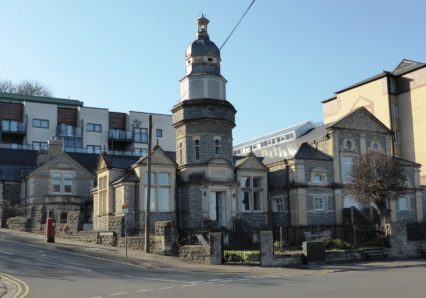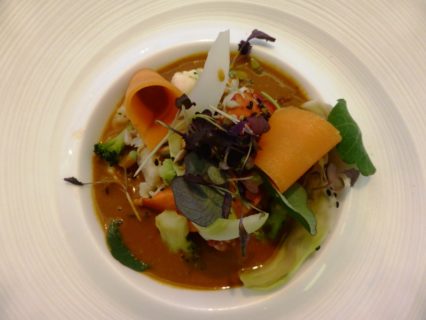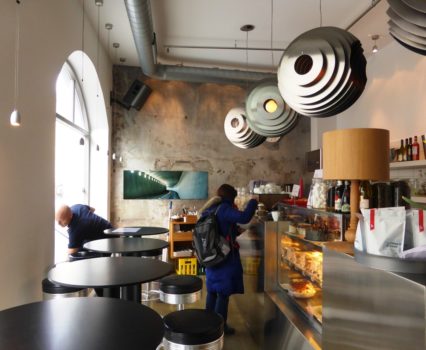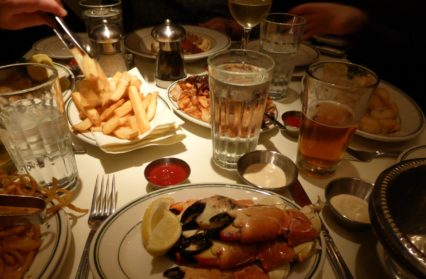Architect Richard Porch examines the connections between culinary trends and the feel of the city experience in describing Penarth and other cities.
One can discover the attractions of a place that one has never visited before as a direct result of a successful meal there. This is good food as a tourist attraction. Think of the Chef Rick Stein’s connection to Padstow in Cornwall and the symbiotic relationship between the two. That said I recently had cause to book a meal at a well-regarded restaurant in Penarth, just outside Cardiff recently.

I’d never been to Penarth before – never had any need to. It is a town that owes its existence mainly to a dock that was built there in 1865 to cope with overflow from the coal trade Cardiff was generating. In 1913 there were 485 collieries in Wales, 323 in Glamorgan alone and South Wales was producing roughly ⅓ of the world’s coal exports. At its peak, coal exports from Penarth in 1913 reached an astonishing 4,660,648 tons. It also subsequently became an exclusive retirement suburb for retired sea captains, coal owners and businessmen. Thinking about it; one good reason for going there would be to see a building by the great Gothic–Revival architect William Butterfield (1814-1900). He built a church (St. Augustine’s) there at the height of his popularity in 1866, complete with trademark interior enlivened by polychromatic brickwork. You can see its distinctive bell tower jutting out of the landscape from virtually anywhere in Cardiff Bay. The dock was subsequently redeveloped as Portway Marina by Chamberlin Powell and Bon & Woods in 1984 and the town looks serenely out into the Bristol Channel.
In the course of an overnight stay after the meal, I was able to discover more about Penarth and its buildings, something which would have never happened otherwise. One can wander the promenade and its largely unremarkable parade of shops but sooner or later one is drawn to the pier and the faux-maritime experience it offers. Notionally Penarth’s pier is late-Victorian but the most architectural bit (the Pier Pavilion) dates from 1927/8, while it is the mid-section that is the original element. Unusually for a seaside town it has some interesting landward architecture and this drew me in and held my attention. Starting near the seafront I was fascinated to see what looked like a Russian Orthodox Church transplanted from Latvia or Riga to South Wales, but which turned out to be Penarth’s public baths built in 1883-5. It still stands on the corner of Bridgeman Road and the Parade and looks seaward towards the pier.
In the intervening 134 years modern Penarth has, in all its flat-roofed glory, swum up around the former baths (sorry) making its survival look even more improbable and yet it still contributes more in terms of arresting townscape than almost anything in the immediate vicinity. Designed by the local firm of Harry Snell & Henry C. Harris its domed tower soared above swimming baths that were once filled with sea water ingeniously drawn from the Bristol Channel via a pumping mechanism on the beach. The baths closed in the 1980s and at the time of writing this the building is up for sale and conversion to apartments. I know all of this because of that meal, which was a delicious 11- course starter menu and which took all of four hours to eat. Another reason for remembering Penarth and for wanting to go back some time. Important that.

The above experience was unusual for me in that having pleasant associations of food and place normally occurs in a foreign context. This is nothing to do with the facility of being able to dine al fresco either. Granted this is seldom possible or even desirable in Britain. Let’s be honest, the advent of pavement eating and drinking in the UK had more to do with the smoking ban which drove smokers out of doors, than with anything to do with a desire to be closer to the life of the street.
The nature of very busy places seems to define what (for want of a more elegant phrase) ‘eating destinations’ will look like. When visiting Florence recently I went looking for somewhere to eat and somewhat inevitably ended up in a small windowless enclave with a barrel-vaulted ceiling. This said; they were always inviting, clad in timber panelling with classical details and had an abundance of frescoes all which seemed to mimic the interiors of many major public buildings there. Lighting levels were low but never gloomy and the net effect was of an enticing snugness that produced a calm refuge away from the hum of the street. Small and confined translated as good.
Alternatively one could dine in the street there amongst the swirl of fellow tourists and inhabitants. I can remember a simple two-course meal that took 20 minutes to eat and was a delight to look at into the bargain. It’s amazing how a few parcels of ravioli artfully arranged with a couple of strands of chive can attain the level of edible art, but in the right hands they can. The aesthetics of food are another subject entirely. A single glass of wine consumed with the meal produced such a sense of wellbeing and calm that my wife began to absentmindedly sketch our surrounding environment. That’s instead of snapping away with cameras trying desperately to freeze such-and-such a moment in time. The consumption of food in a pleasant setting slows down your pace and changes your mood by (literally) buying you the time and space in which to think. It amounts to respite.
A few years ago my wife and I visited Chicago in November and after a somewhat chilly boat trip designed to highlight the architecture of the Loop District from the river, we decided on a meal at a nearby restaurant. In the course of the stay I had discovered a Californian Pale Ale called Lagunitas which at 6.5% abs had a powerful kick especially if delivered on an empty stomach. We dined simply on crab claws from Maine, onion rings and French fries all washed down with Lagunitas. The latter has a deceptively smooth taste in common with a lot of other pale ales and 2-3 bottles were gulped down without mishap. I left the restaurant pleasantly full and with a glow generated by a decent craft beer from an unexpected source. As a result; the walk back to the hotel through a city dotted with Modernist architecture by Mies Van Der Rohe was only enhanced by the buzz produced by the alcohol. When I think of Chicago I think of that river trip, the food and drink, and the walk afterwards. The meal was certainly no culinary adventure merely a light repast after a successful afternoon looking at architecture; linking the two things together (for me) nearly always makes for an enjoyable experience. Sitting down to eat afterwards begins the gestation process of reflecting on what one has seen.

Food or meals in a new city are usually a by-product of a day spent exploring, a reward for all the foot-slogging. I had a bar meal in the small Norwegian fishing port of Ålesunde (pop. 47,177) recently which made that point. We’d spent the day exploring this town at the entrance to the Geiranger fjord on the ragged west coast of Norway. Interestingly in addition to being a fishing port Ålesunde has one of the largest continuous sequences of Jugendstil* architecture in Europe. This alone is enough of a reason for going there – its rocky topography and proximity to the fjords is another. Becoming hungry around midday we spotted one of the many independent coffee shops to be found there.
Looking for a bar is more problematic as there is no culture of pubs or public drinking in Ålesunde, but there is an abundance of clean, modern coffee houses. We found one called ‘Invit’ which had a streetfront cafe, a larger internal eating and drinking area that faced into the adjacent river and you could even eat on a floating pontoon outside. We just ordered coffee and a bowl of a warming vegetable soup accompanied by two different types of bread. Invit is almost the epitome of ‘trendy’ yet has that Scandinavian knack of being friendly and comfortable at the same time. Not for nothing is Invit Norwegian for ‘invitation’. We lingered for a good hour over the food before setting off to look at the marvellous inheritance of Jugendstil architecture built during the period 1904-07. This came about because Ålesunde was originally built of timber and had to be rebuilt in stone after a fire which almost entirely destroyed it in 1904. Whenever I think of Ålesunde’s Jugendstil suburb I also think of the Invit cafe and that bowl of soup on a cold day in early March.
Architecture frames our experience of towns and cities; it too can be a mixture of ‘great’ architecture and a lot more humble stuff. Good food (however you define it) provides an important supplement to the genius loci that can help draw you into the indefinable magic of a place and confirm or (alas) deny it. In the same way one can acknowledge a successful palette of materials used in the construction of a building so too can an enjoyable meal form a component part of successful place-making.
*Jugendstil literally translated just means “youth style” but in the context of the late 19th century in Northern Europe it is the German term for the art movement known as Art Noveau.
Richard Porch is a regular contributor at Wales Arts Review.











